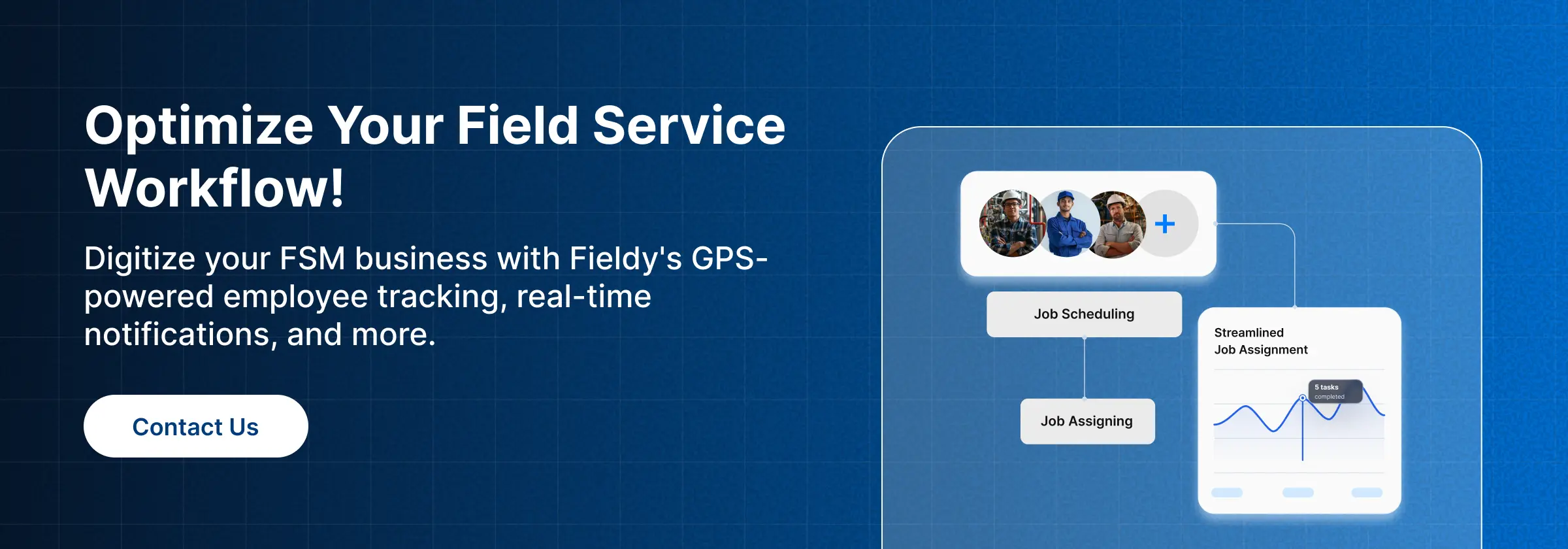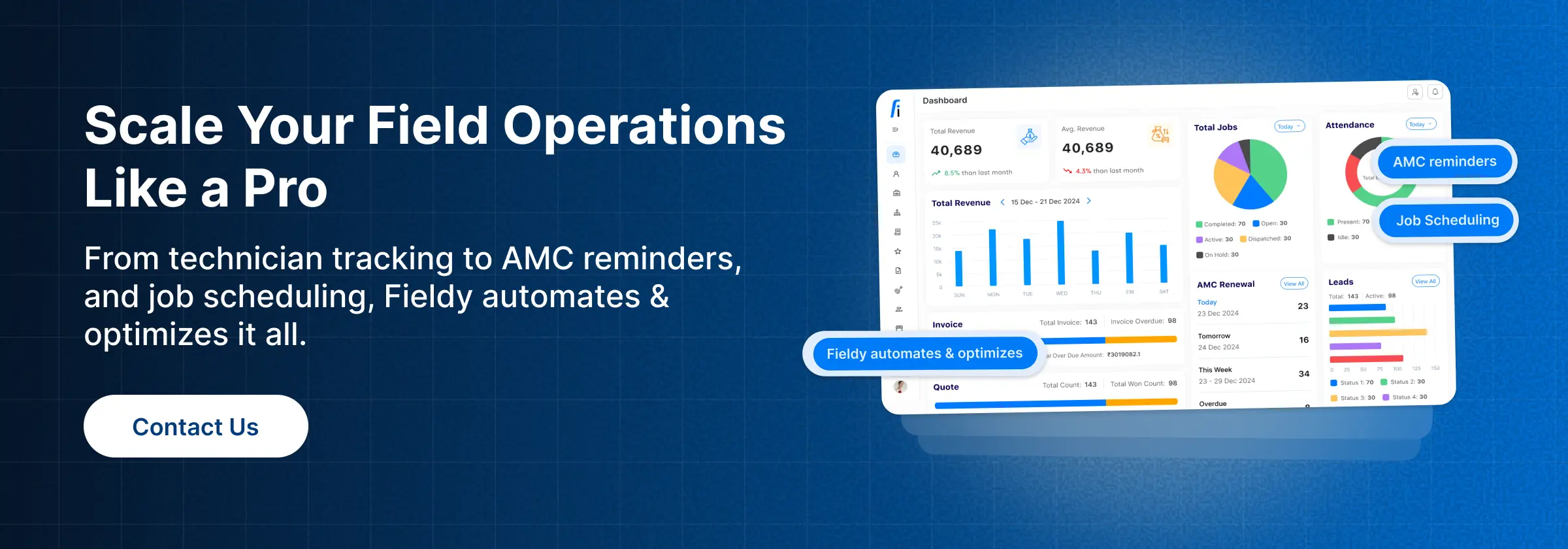📝Introduction
From a broad point of view, field service optimization is the art of creating smarter service businesses, faster service businesses, and more profitable ones. For businesses that send out technicians and manage fleets or customer appointments, field service optimization ensures that every resource is used toward maximum capacity.
Today, in 2025, this has fascinated me in awe. Increasing fuel prices, decreasing profits, and customers demanding Uber-like tracking and Amazon-like convenience have pushed inefficiency to the backseat. Scheduling, workforce management, and routing must be optimized. Fieldy’s Field Service Management software brings together these requirements to help balance customer needs with operational efficiency. In the same way homeowners often ask how much does it cost to maintain a home elevator to budget long-term, service businesses too must calculate and plan their operational costs with precision. It is then important to have a better understanding of work order management best practices, as they are the key to any efficient field operation.
💹What is Field Service Optimization?
Field service optimization is about improving the manner in which a company manages a mobile workforce, scheduling, and its daily operations. Instead of dealing with problems as they come, companies are now taking a cost-based, data-driven approach to delivering services faster and with higher customer satisfaction.
Just as homeowners consider how much does it cost to maintain a home elevator when planning for efficiency and long-term upkeep, businesses too must apply the same forward-thinking approach to optimize costs and resources in field operations.
The big categories it fall under include:
| ⚙️ Optimization Category | 📖 Example / Impact |
|---|---|
| 📝 Field Service Workflow Optimization | Repetitive tasks like assignment, invoicing, and reporting are automated. A telecom company digitizing workflows reduced their paperwork by 40% and delayed jobs by 50% – a strong example of structured process improvement. |
| 👷 Field Service Workforce Optimization | Focuses on utilization of technicians and workload balancing. Companies that introduced workforce optimization tools became 18% better at making first-time fixes, increasing profitability and customer loyalty (ServiceMax). |
| 🚚 Fleet & Field Service Operations Optimization | Reduces travel costs and idle times. A plumbing company in Texas implemented GPS-powered fleet tracking and saw a 15% reduction in fuel consumption within a year. |
When combined with employee productivity tracking in field service, these strategies form a complete optimization framework that supports sustainable growth.
🚚 What is Field Service Route Optimization?
Field service route optimization is the use of software and AI to assign the best travel routes to technicians. By analyzing distance, traffic, job priority, and technician availability, businesses can minimize wasted time and fuel. Just as facility managers often ask how much does it cost to maintain an elevator to balance upkeep expenses with reliability, service companies leverage route optimization to balance operational costs with customer satisfaction.
✅ Benefits of Route Optimization:
| ✅ Benefit | 📖 Explanation |
|---|---|
| 💸 Lower Fuel Expenses | Route optimization reduces average travel distance per job by up to 20%, according to Gartner’s 2024 FSM study. |
| 📈 Higher Job Completion Rates | Optimized routes allow technicians to complete extra service calls each day, improving overall productivity. |
| ⏱ Faster Response Times | Customers benefit from quicker arrivals, which translates into higher satisfaction and retention. |
🚨 Case Example:
An HVAC company using Fieldy’s real-time GPS tracking reduced customer wait times by 35% and completed two more jobs per technician per day. Integrating these insights with tools for making HVAC more efficient using FSM software amplified both cost savings and service quality. ⬇️
🌍Key Areas of Optimization in Field Service
⚖️Resource Scheduling Optimization in Field Service
Resource scheduling optimization in field service ensures jobs are assigned based on technician skills, availability, and proximity. This prevents underqualified technicians from being dispatched to complex jobs or technicians driving long distances unnecessarily.
A UK-based security systems provider improved its first-time fix rate by 22% after adopting skill-based scheduling. Missed appointments also dropped by 15% because the right technician was always assigned to the right task. Many companies rely on advanced field service scheduling software to achieve this.
🔗Workflow Automation
Automating workflows reduces human errors and frees up managers to focus on strategic tasks. Tools like digital job cards, auto-dispatch, and automated AMC renewals are key.
A field services contractor in India digitized AMC contracts and cut missed renewals by 30%. Similarly, companies using automated dispatch reported saving 1–2 hours per manager daily.
Workflow automation lies at the core of field service workflow optimization, ensuring teams don’t waste time on repetitive tasks. Businesses that follow the latest checklists for field service software in 2025 are already seeing faster service delivery and better compliance.
🚚Fleet & Route Optimization
Fleet optimization and field service route optimization are closely tied. GPS tracking systems give managers visibility into technician movements, helping to minimize idle time and fuel waste.
Studies show that companies adopting telematics and route optimization cut fleet operating costs by up to 12%. Beyond cost savings, this contributes to sustainability, lowering the carbon footprint of mobile operations.
For instance, a pest control company in Florida used fleet optimization to reduce idle time by 18% while still increasing total job volume. This balance is at the heart of optimizing fleet and field service operations for maximum output.
📉 Workforce Productivity Tracking
No optimization effort is complete without monitoring KPIs. Businesses need to track:
- Jobs per day per technician
- Travel time vs service time
- Customer ratings after service
A home repair franchise that tracked these KPIs discovered that customer ratings were directly tied to shorter travel times. By adjusting technician routing, they increased 5-star reviews by 25%. Companies applying best practices for improving employee productivity in field service find it easier to connect operational efficiency with customer experience.
🌟 Benefits of Field Service Optimization Software
When done right, field service optimization has wide-ranging benefits:
| ✅ Benefit | 📖 Explanation |
|---|---|
| 💰 Reduced Operational Costs | McKinsey research shows companies can reduce FSM costs by 10–15% through digital optimization. |
| 🔧 Higher First-Time Fix Rates | Accurate scheduling and skill matching drive resolution on the first visit. |
| 🌟 Better Customer Experience | Real-time updates and transparent service tracking keep customers informed. |
| 🏢 Scalability for Multi-Location Businesses | Optimized processes are easier to replicate across branches or franchises. |
Field leaders comparing options in a field service management software comparison for 2025 consistently highlight these as top differentiators.
🚀 Why Fieldy is the Best Choice for Field Service Optimization
Fieldy FSM software is designed with optimization at its core. Businesses choose it because it combines:
- 🏗️ Advanced resource scheduling optimization – Matches jobs to technicians based on skills, availability, and proximity, improving first-time fix rates and reducing downtime.
- 📍Live route tracking and re-routing – GPS tools allow managers to monitor progress and quickly reroute technicians during delays or emergencies, keeping SLAs on track.
- 🔁Automated workflow tools – Digital job cards, checklists, and AMC reminders replace paperwork, helping technicians close jobs faster and ensuring better coordination.
- 💬Industry-specific solutions – FSM platforms offer tailored features for HVAC, plumbing, electrical, pest control, and security businesses, addressing their unique operational needs.
An electrical contracting company using Fieldy cut its overtime costs by 20% and grew repeat business by 17% within six months. Businesses exploring the best HVAC software for small companies or security system FSM solutions often find Fieldy the most adaptable platform.
🌟Conclusion
Field service optimization and field service route optimization are no longer optional, they are survival strategies for 2025 and beyond. By optimizing workflows, workforce productivity, fleet operations, and scheduling, businesses reduce costs while delighting customers. Much like asking how much does it cost to maintain a home elevator to ensure long-term safety and efficiency, field service businesses must weigh the operational costs of inefficiency versus the benefits of structured optimization.
With platforms like Fieldy, optimization becomes accessible, data-driven, and scalable across industries. For any field service business aiming to grow sustainably, optimization is the new competitive advantage. ⬇️
📊 FAQs
Why is field service optimization critical in 2025?
Because rising costs and customer expectations demand smarter operations. Optimized processes allow businesses to serve more customers at lower costs.
How does field service route optimization improve profitability?
It cuts fuel costs, increases jobs completed daily, and reduces unproductive travel—directly boosting margins.


![What is Field Service Optimization and Route Optimization? [2025 Guide]](https://blog-admin.getfieldy.com/wp-content/uploads/2025/10/What-is-Field-Service-Optimization-and-Route-Optimization.webp)

